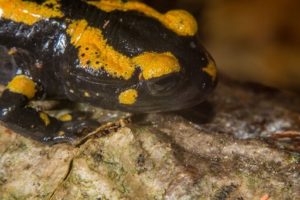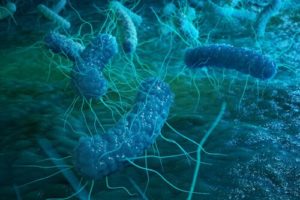The Fire salamander is the largest, and possibly the best-known salamander species in Europe. These salamanders live throughout Southern, Central, and Eastern Europe with some subspecies being found as far as North Africa. They are characterized by their glossy black body with yellow patches or stripes.
Fire salamanders have large parotid glands behind the eyes and two rows of poison glands running along the back that secrete highly potent neurotoxins as a defense against predators.
They are also capable of squirting these toxins up to a foot away, into the eyes or mouth of would-be predators.
Despite their toxin, fire salamanders are unlikely to cause any problems as long as their toxin is not ingested. To be safe, do not handle fire salamanders unless necessary.
When you do handle them, take a few safety precautions (such as wearing protective gloves) and wash your hands with antibacterial soap after.
Bright Yellow Patches Warn of the Fire Salamanders Toxicity
In the animal world, many poisonous animals advertise their toxicity by having bright or contrasting colors (usually black, white, orange, yellow, red, or a combination of these colors).
This is called “aposematism” or “warning coloration”. It signals to predators that the animal is toxic and would make a horrible meal.

The bright yellow colors of the fire salamander warn would-be predators that the salamander is poisonous.
An animal that eats a brightly colored fire salamander will get sick; the next time it sees another similarly colored salamander, it will associate the bright colors with poison and learn to avoid it. In this way, the coloration acts as a defense on its own.
Fire Salamanders’ Poison Glands Are Usually on the Yellow Parts of Their Body
The poison glands of fire salamanders are usually located on the yellow patches on their body. This led many people to theorize that the more yellow a fire salamander has on its body, the more toxic it is.
However, recent research has shown that not to be true. The research showed that fire salamanders are sexually dichromatic (differences in appearance between males and females of the same species), with males more yellow than females.
Sex and location (subspecies) are the biggest factors in determining how much black and how much yellow a fire salamander will have.
Fire Salamanders Produce an Extremely Potent Toxin
When threatened, the salamanders will secrete these toxins all over their skin. They can also actively defend themselves by spraying the toxins from the enlarged parotid glands behind their eyes.

That said, you should know that the fire salamanders toxins have more than one use. They do not only protect the salamanders from predators, but also from bacterial and fungal infections such as chytridiomycosis.
Chytridiomycosis is an infectious disease caused by a parasitic fungus known as ‘Chytridiomycota’. This fungus grows on the surface of the skin of amphibians, causing damage to the outer layer of skin.
Since amphibians breathe through their skin, the damage caused by this fungus disrupts their respiration and can prove to be fatal.
Fire Salamanders Are Poisonous but Have No Venom
If you are like most people, you use occasionally use the words “poisonous” and “venomous” interchangeably.
But, you should know that there is a difference between these two concepts. Most poisonous animals are not venomous, and most venomous animals are not poisonous. Confused?
To make things simple:
- If an animal has to bite or sting you to inject its toxins, it is venomous.
- If an animal secretes its toxins outside of its body, and you absorb the toxins when you come in contact with the animal, it is poisonous.
This means coral snakes, scorpions, and many spiders are venomous, while poison dart frogs, fire salamanders, and many newts are poisonous.
Are Fire Salamanders Dangerous to Humans?
Despite their skin toxins, fire salamanders are unlikely to cause any problems to humans provided they are handled carefully and gently. The only danger comes when their toxins are ingested; so as long as you don’t lick or eat fire salamander, you should be safe.
Since most people won’t try to eat or lick a fire salamander, the most likely way you would ingest the toxins would be by handling a fire salamander with your bare hands, then rubbing your eyes, or touching your mouth without first washing your hands.
Doing this would enable the toxins to be ingested into your body, and most likely lead to irritation. Ingesting sufficient quantities of this toxin, particularly through the mouth, can be very dangerous or even fatal.
Also, handling a fire salamander with scratches or cuts on your hands can lead to a burning sensation when to toxin comes in contact with the wounds.
For this reason, you should never handle fire salamanders unless necessary. When you do handle them, take a few safety precautions and wash your hands after.
It’s Not Just the Toxins You Should Be Worried About
Fire salamanders, like most amphibians, can be carriers of salmonella and other bacteria or parasites that can be harmful to humans. Salamanders with salmonella usually do not look sick in any way but can pass the bacteria to humans.
You can be exposed to salmonella through contact with the salamander, its feces, or any object the salamander touches.

Exposure to salmonella can cause an infection called salmonellosis. This infection is usually non-life-threatening but can spread to the bloodstream or nervous system and lead to severe illness.
Fortunately, merely touching a fire salamander will not make you sick. The bacteria need to make their way into your body (just like the toxin) before it can cause illness.
Are Fire Salamanders Dangerous Pets?
Since fire salamanders have a potent toxin, a pet (such as a dog or cat) that eats, licks, or mouths fire salamander is at risk of poisoning. Most of the time, this will only make the pet seriously sick. However, if sufficient quantities of the toxin are ingested, it can be fatal.
For this reason, keep your pets away from salamanders and other amphibians. If you have pet salamanders at home, keep them secured in their enclosure so they do not have contact with any of your other pets.
Check out this post where I go into more detail on the topic.
Safety Precautions to Take When Handling Fire Salamanders
Generally, it is not a good idea to handle amphibians, because they have semi-permeable skin which can absorb water, oxygen, and other soluble substances.
This means oils, slats, perfumes, lotions, and other substances on your hands can pass right through their skin and end up inside their body.
For this reason, you should keep your salamander handling to a minimum. Should you ever decide to handle a salamander, take the following precautions.
Before Handling:
- Wash your hands very thoroughly and make sure they are clean from all soap residue or any other substances that can harm the salamander.
- After washing, dry them and re-wet them with dechlorinated water
The gloves also have to be moistened with dechlorinated water.
How to Safely Handle:
- Gently pick up the salamander and allow it to walk on your hand without restraining it. The salamander will just sit and walk across your hands.
- Do not put any stress on the salamander because if you do, it will feel threated and secrete its toxin all over your hands.
- Keep the salamander away from your eyes nose and mouth and, be very careful not to touch your face.
Salamanders should only be handled for a short time. Handling a salamander for too long can cause stress to the animal.
After Handling:
- Wash your hands with anti-bacterial soap
Even if you were wearing gloves, I recommend going the extra mile and washing your hands. As mentioned earlier, fire salamanders have toxins and potential carry bacteria that can be harmful so best to protect yourself.
Before washing your hands, do not touch your face or put anything in your mouth.
Final Thoughts
Fire salamanders are beautiful animals that are popular pets because of their beautiful coloration and hardy nature. They produce a toxin to defend themselves against predators, but this toxin is only harmful when it is ingested.
The risk of poisoning can be significantly reduced by simply wearing gloves and observing sufficient hygiene in the handling of fire salamanders. With proper handling, these salamanders can be harmless creatures.
If you ever suspect poisoning, do not hesitate to seek professional medical attention!


